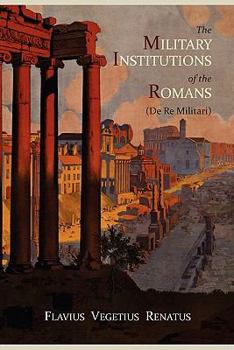The Military Institutions of the Romans (de Re Militari)
Select Format
Select Condition 
Book Overview
De Re Militari by Vegetius is the famous strategy book written in times of the Roman Empire. It explains how they organized their armies, battles, sieges, and war strategies. This is the complete... This description may be from another edition of this product.
Format:Paperback
Language:English
ISBN:1614270554
ISBN13:9781614270553
Release Date:June 2011
Publisher:Martino Fine Books
Length:114 Pages
Weight:0.40 lbs.
Dimensions:0.3" x 6.0" x 9.0"
Customer Reviews
3 ratings
A Fascinating Window into Military Practices of Late Antiquity
Published by Thriftbooks.com User , 14 years ago
An easy to read but fascinating insight into late antiquity. This book was written at a time when the Roman empire in the West was in steady decline. Under contunious pressure from barbarian tribes, Roman military men of the time were seeking ways to reform the Roman army, hearkening back to the glory days of the late Republic and early Imperial periods, when the Roman military machine had no equal in the known world. Flavius Vegetius wrote this book as a set of recommended military reforms for the emperor. Alas, while it proved a matter of "too little, too late" for the west, it still offers us a very telling window into the past.
Definitive Primary Source On the Conduct Of Roman Warfare
Published by Thriftbooks.com User , 17 years ago
I read this book for a graduate course in Roman history. It is important to understand that the army of the Republic was by no means a second rate militia force. "Discipline and training were its hallmarks; the care with which the camp was laid out reveals no ordinary grouping of amateur warriors. The Romans adopted professional attitudes to warfare long before the army had professional institutions." The army's professionalism is proven by reading the one military training manual still extant, Vegetiu's fourth century CE Epitome of Military Science. Most experts agree that Vegetius' Epitome was certainly a compilation of earlier Roman military training and doctrine manuals that have not survived. This manual is replete with information for the commander on how to recruit, train, supply, billet, and employ his legion in combat. Rome had an army from its earliest beginnings as a small city-state. There is little known of the structure of the military in early Roman history. "At first, military service in the Roman Army entailed a man being away from his home...for a few weeks or months over the summer. The campaign season opened in March and closed in October, as official festivals in the Roman calendar make clear." Servius Tullius was the sixth king of Rome who reigned from about 580-530 BCE. Servius instituted many reforms in both the political and military structures of Rome which were codified in the Sevian Constitution. He conducted the first census of the citizenry and used this information to divide the population into classes based on wealth. The class structure was then used both politically for voting classification and militarily to determine in what portion of the legion a man would serve in to defend Rome. The men were organized into centuries (hundreds) within the class structure. Militarily, the class ranking was based on wealth, which determined where a man would serve in the legion based on his ability to provide his own weapons and equipment. The wealthiest class in Roman society served in the equites or the Roman cavalry, of which there were eighteen centuries. Obviously, these men had the financial ability to provide their own horses. The majority of the population was divided into five classes who served in the infantry. Men who had no property had no military obligation. The military tactics used were similar to the Greek hoplite formation. "Members of the `first class' were to be armed with a bronze cuirass, spear, sword, shield and greaves to protect the legs; the `second class' with much the same panoply minus the cuirass; the `third', the same but lacking the greaves; the `fourth; the shield and spear only, and the `fifth' was armed only with slings or stones. During the period of the Republic, the structure of the army went through some changes after the enactment of the Servian Constitution. When a Roman citizen volunteered or was drafted, it was to fight in a specific campaign rather than
applicable today as well
Published by Thriftbooks.com User , 24 years ago
It is a wonder to me that more people have not discovered translations such as this one, Vegetius's seminal work "Epitome of Military Science". Compare Vegetius to such works as the Sun Tzu's "Art of War", but put it in the perspective of Ancient Rome and you'll be spot on.I liked this work because it gave an excellent insight into all aspects of managing military groups. It covered not only things such as troup placement and tactics, but also much baser aspects of military life, such as the logistics of training, what or how to feed large numbers of troops, and how to deal with troop morale.For the historian (and members of re-enactment groups similar to the SCA) this is an excellent book for research if you're willing to ignore the fact that the text is only the English translation and not a side-by-side comparison of the original and the modern.






